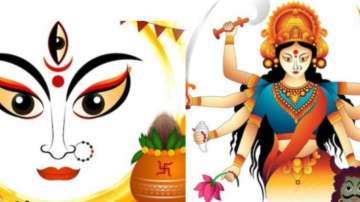Navratri is one of the most auspicious and celebrated Hindu festivals in India. It is an elaborate nine-day festival that celebrates the divine feminine power of Shakti. The first day of Navratri is celebrated with great enthusiasm and fervour all over India.
When is Shardiya Navratri?
Shardiya Navratri or Maha Navratri falls in the month of Ashwin according to the Hindu lunar calendar, which falls during September or October according to the Gregorian calendar. It usually starts on the Pratipada (first day) of Ashwin month and ends on the Navami (ninth day) of Ashwin month. This year, Shardiya Navratri will begin on October 15, 2023 and conclude on October 24, 2023.
Puja Vidhi:
The puja vidhi or the rituals include a traditional system of worshipping Goddess Durga for nine days along with her nine forms. On each day, devotees offer puja to Maa Durga in her different forms. The puja consists of chanting mantras, singing devotional songs, offering flowers, fruits, incense sticks and other items to please Maa Durga. The puja also includes performing aarti and distributing prasad among devotees.
Rituals:
On each day of Navratri, devotees perform special rituals and celebrate each day differently in honour of Goddess Durga. On Pratipada (first day), devotees worship Goddess Shailputri (Goddess Parvati). On Dwitiya (second day), Goddess Brahmacharini (Goddess Parvati) is prayed to. On Tritiya (third day), Goddess Chandraghanta (Goddess Parvati) is worshipped. On Chaturthi (fourth day), Goddess Kushmanda (Goddess Durga) is worshipped. On Panchami (fifth day), Goddess Skandamata (Goddess Parvati) is worshipped. On Shashthi (sixth day), Goddess Katyayani (Goddess Durga) is worshipped. On Saptami (seventh day), Goddess Kalaratri (Goddess Durga) is worshipped. On Ashtami (eighth day), Goddess Mahagauri (Goddess Parvati) is worshipped. On Navami (ninth day), Goddess Siddhidatri (Goddess Lakshmi) is worshipped.
Significance:
Navratri holds great significance for Hindus as it celebrates the power of femininity and creativity. It also symbolises victory over evil forces like ego and arrogance. The festival is celebrated with great enthusiasm across India as it brings good luck and prosperity in one’s life. People attend special poojas, perform rituals and make offerings to Maa Durga to seek her blessings for a prosperous year ahead.
Other details:
Maa Durga represents strength, courage and power; therefore, many devout Hindus observe fast during these nine days of Navratri to pay their respects to her divinity. People also wear traditional clothes during this festival and dress up their homes with images of Maa Durga to mark this special occasion. Special kheer dishes are prepared on each day and distributed among family members and friends to celebrate this joyous occasion with one another.
ALSO READ: When is Durga Puja 2023? Know date, Puja timings, history and other important details
